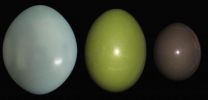(Press-News.org) An ancient meteorite and high-energy X-rays have helped scientists conclude a half century of effort to find, identify and characterize a mineral that makes up 38 percent of the Earth.
And in doing so, a team of scientists led by Oliver Tschauner, a mineralogist at the University of Las Vegas, clarified the definition of the Earth's most abundant mineral - a high-density form of magnesium iron silicate, now called Bridgmanite - and defined estimated constraint ranges for its formation. Their research was performed at the Advanced Photon Source, a U.S. Department of Energy (DOE) Office of Science User Facility located at DOE's Argonne National Laboratory.
The mineral was named after 1964 Nobel laureate and pioneer of high-pressure research Percy Bridgman. The naming does more than fix a vexing gap in scientific lingo; it also will aid our understanding of the deep Earth.
To determine the makeup of the inner layers of the Earth, scientists need to test materials under extreme pressure and temperatures. For decades, scientists have believed a dense perovskite structure makes up 38 percent of the Earth's volume, and that the chemical and physical properties of Bridgmanite have a large influence on how elements and heat flow through the Earth's mantle. But since the mineral failed to survive the trip to the surface, no one has been able to test and prove its existence - a requirement for getting a name by the International Mineralogical Association.
Shock-compression that occurs in collisions of asteroid bodies in the solar system create the same hostile conditions of the deep Earth - roughly 2,100 degrees Celsius (3,800 degrees Farenheit) and pressures of about 240,000 times greater than sea-level air pressure. The shock occurs fast enough to inhibit the Bridgmanite breakdown that takes place when it comes under lower pressure, such as the Earth's surface. Part of the debris from these collisions falls on Earth as meteorites, with the Bridgmanite "frozen" within a shock-melt vein. Previous tests on meteorites using transmission electron microscopy caused radiation damage to the samples and incomplete results.
So the team decided to try a new tactic: non-destructive micro-focused X-rays for diffraction analysis and novel fast-readout area-detector techniques. Tschauner and his colleagues from Caltech and the GeoSoilEnviroCARS, a University of Chicago-operated X-ray beamline at the APS at Argonne National Laboratory, took advantage of the X-rays' high energy, which gives them the ability to penetrate the meteorite, and their intense brilliance, which leaves little of the radiation behind to cause damage.
The team examined a section of the highly shocked L-chondrite meteorite Tenham, which crashed in Australia in 1879. The GSECARS beamline was optimal for the study because it is one of the nation's leading locations for conducting high-pressure research.
Bridgmanite grains are rare in the Tenhma meteorite, and they are smaller than 1 micrometer in diameter. Thus the team had to use a strongly focused beam and conduct highly spatially resolved diffraction mapping until an aggregate of Bridgmanite was identified and characterized by structural and compositional analysis.
This first natural specimen of Bridgmanite came with some surprises: It contains an unexpectedly high amount of ferric iron, beyond that of synthetic samples. Natural Bridgmanite also contains much more sodium than most synthetic samples. Thus the crystal chemistry of natural Bridgmanite provides novel crystal chemical insights. This natural sample of Bridgmanite may serve as a complement to experimental studies of deep mantle rocks in the future.
Prior to this study, knowledge about Bridgmanite's properties has only been based on synthetic samples because it only remains stable below 660 kilometers (410 miles) depth at pressures of above 230 kbar (23 GPa). When it is brought out of the inner Earth, the lower pressures transform it back into less dense minerals. Some scientists believe that some inclusions on diamonds are the marks left by Bridgmanite that changed as the diamonds were unearthed.
INFORMATION:
The team's results were published in the November 28 issue of the journal Science as "Discovery of bridgmanite, the most abundant mineral in Earth, in a shocked meteorite," by O. Tschauner at University of Nevada in Las Vegas, N.V.; C. Ma; J.R. Beckett; G.R. Rossman at California Institute of Technology in Pasadena, Calif.; C. Prescher; V.B. Prakapenka at University of Chicago in Chicago, IL.
This research was funded by the U.S. Department of Energy, NASA, and NSF.
Argonne National Laboratory seeks solutions to pressing national problems in science and technology. The nation's first national laboratory, Argonne conducts leading-edge basic and applied scientific research in virtually every scientific discipline. Argonne researchers work closely with researchers from hundreds of companies, universities, and federal, state and municipal agencies to help them solve their specific problems, advance America's scientific leadership and prepare the nation for a better future. With employees from more than 60 nations. Argonne is supported by the Office of Science of the U.S. Department of Energy. The Office of Science is the single largest supporter of basic research in the physical sciences in the United States, and is working to address some of the most pressing challenges of our time. For more information, please visit science.energy.gov.
Chicago, IL, and New Haven, CT, December 12, 2014 - The Yale School of Forestry & Environmental Studies and The Associated Press-NORC Center for Public Affairs Research today released the first set of findings from its inaugural environment poll. The poll surveys a nationally representative sample of American adults and provides a portrait of what the public thinks and feels about environmental issues, and what actions they are taking as consumers.
Findings from the first report indicate that most Americans say the United States ought to take a leadership role in combating ...
VIDEO:
A wide-field movie by GOES-WEST of the North Pacific from Dec. 9-12, 2014 reveals the violent rain storms pouring moisture on the "Pineapple Express " jet stream into California in mid-December....
Click here for more information.
The ''Pineapple Express'' happens when warm air and lots of moisture are transported from the Central Pacific, near Hawaii, to the Eastern Pacific Ocean. An animation of satellite imagery from NOAA's GOES-West satellite showed the stream of ...
Tropical Cyclone Bakung is moving in a westerly direction over the open waters of the Southern Indian Ocean and NASA's Aqua satellite captured an image of the sea storm.
Aqua passed over Bakung on Dec. 12 at 07:35 UTC (2:35 a.m. EST) and the MODIS instrument aboard took a visible image of the storm. The image showed that deeper convection (stronger currents of rising air that form the thunderstorms that make up the tropical cyclone) was occurring around the low-level center of circulation, so the center was not apparent in the MODIS imagery. The bulk of the clouds associated ...
Splashy blue and green hues pop from under the glassy finish of the Tinamou species' (bird relatives of ostriches, rheas and emus) eggs. Pigments covered by a thin, smooth cuticle reveal the mystery behind these curious shells, University of Akron researchers discovered. The finding could lead to the development of glossy new coatings for
ceramics and floors, potentially enhancing their aesthetic qualities and durability.
After removing the outer layer of the eggshells and examining their chemistry and nanostructure, the researchers discovered the presence of a weak ...
Extreme climate and weather events such as record high temperatures, intense downpours and severe storm surges are becoming more common in many parts of the world. But because high-quality weather records go back only about 100 years, most scientists have been reluctant to say if global warming affected particular extreme events.
On Wednesday, Dec. 17, at the American Geophysical Union's Fall Meeting in San Francisco, Noah Diffenbaugh, an associate professor of environmental Earth system science at the Stanford School of Earth Sciences, will discuss approaches to this ...
PHILADELPHIA -- Frequent kidney dialysis is essential for the approximately 350,000 end-stage renal disease (ESRD) patients in the United States. But it can also cause systemic inflammation, leading to complications such as cardiovascular disease and anemia, and patients who rely on the therapy have a five-year survival rate of only 35 percent. Such inflammation can be triggered when the complement cascade, part of the body's innate immune system, is inadvertently activated by modern polymer-based dialysis blood filters. New work by Penn researchers has found an effective ...
Like a smart sensor that adjusts the lighting in each room and a home's overall temperature, a protein that governs the making of other proteins in the cell also appears capable of controlling fat levels in the body.
The finding, which appeared in Cell Reports on Dec. 11, applies to the Maf1 protein in worms.
A version of the protein, which exists in humans, also regulates protein production in the cell, raising the possibility that it too may control fat storage. A protein with such a function would offer a new target for pharmaceuticals to regulate fat, said Sean ...
The Perioperative Surgical Home (PSH) model consistently and significantly improves quality of care for patients and reduces health care costs, reports a first-of-its-kind, large-scale literature review of the PSH in the United States and abroad. The review, published online this month in Milbank Quarterly, provides further evidence to support the benefits, and encourage the adoption, of the PSH model.
"There is a global push for more rigorously coordinated and integrated management of surgical patients to enhance patient satisfaction and improve quality of care and ...
Oil reservoirs are scattered deep inside the Earth like far-flung islands in the ocean, so their inhabitants might be expected to be very different, but a new study led by Dartmouth College and University of Oslo researchers shows these underground microbes are social creatures that have exchanged genes for eons.
The study, which was led by researchers at Dartmouth College and the University of Oslo, appears in the ISME Journal. A PDF is available on request.
The findings shed new light on the "deep biosphere," or the vast subterranean realm whose single-celled residents ...
BOZEMAN, Mont. - Cathy Cripps doesn't seem to worry about the grizzly bears and black bears that watch her work, but she is concerned about the ghosts and skeletons she encounters.
The ghosts are whitebark pine forests that have been devastated by mountain pine beetles and white pine blister rust, said the Montana State University scientist who studies fungi that grow in extreme environments. The skeletons are dead trees that no longer shade snow or produce pine cones. The round purple pine cones hold the seeds that feed bears, red squirrels and Clark's nutcracker birds. ...



